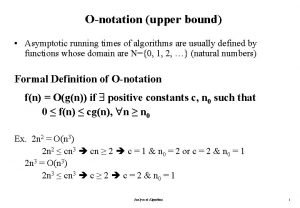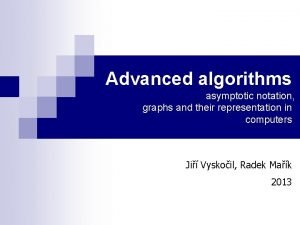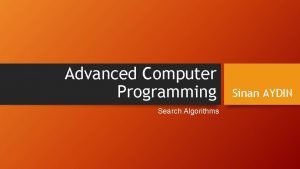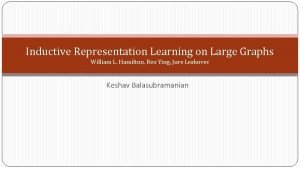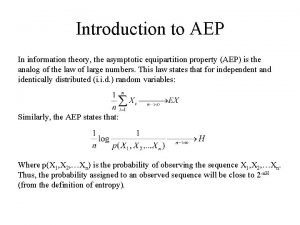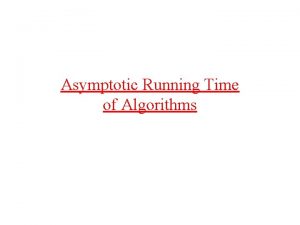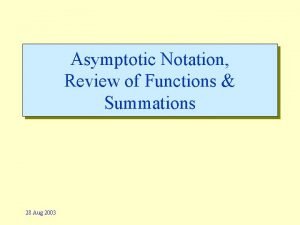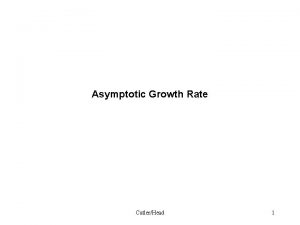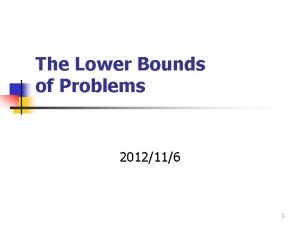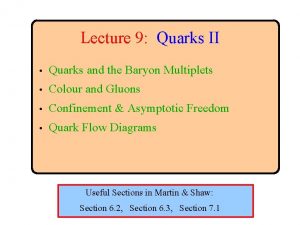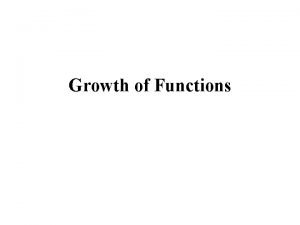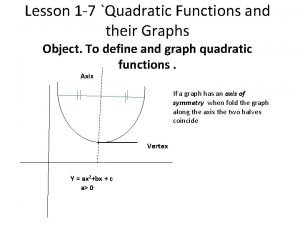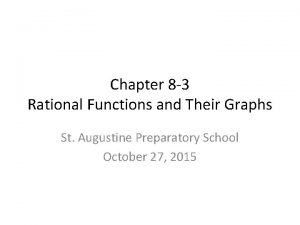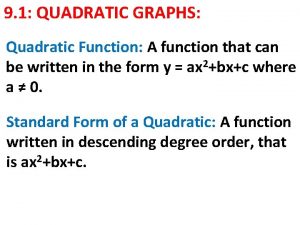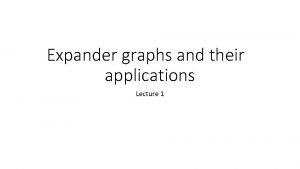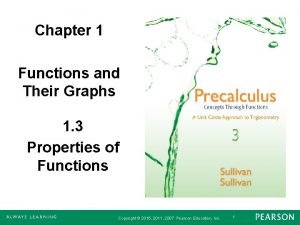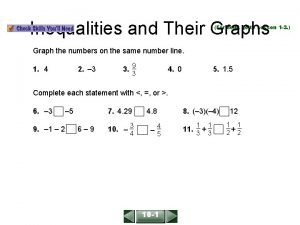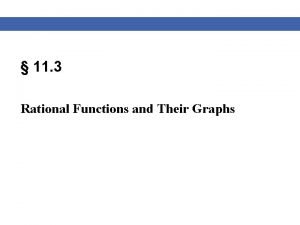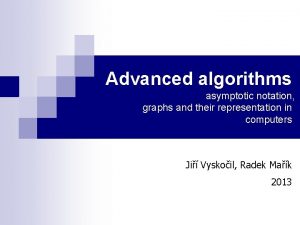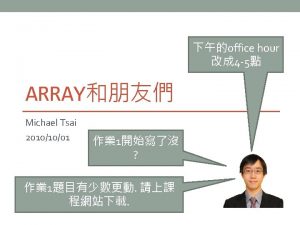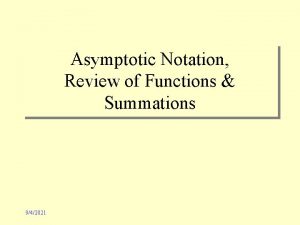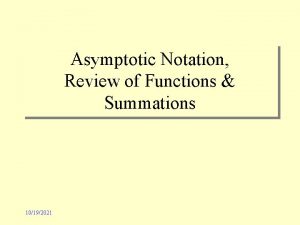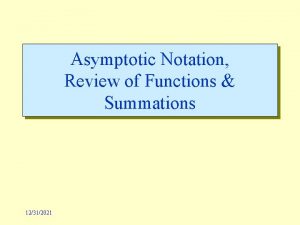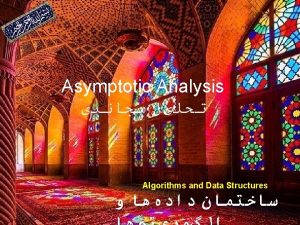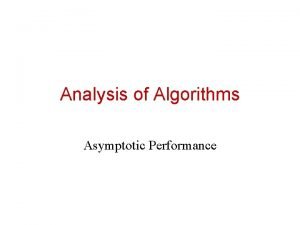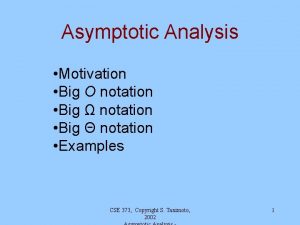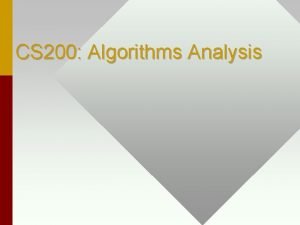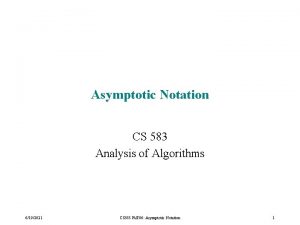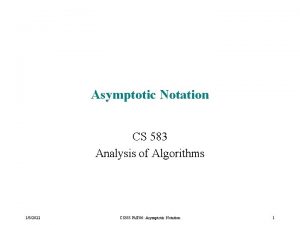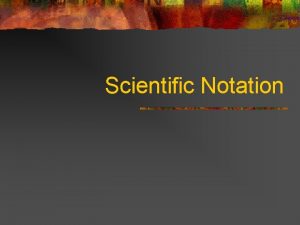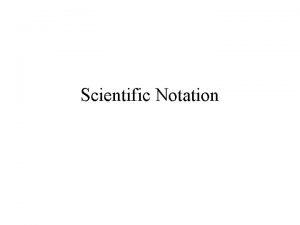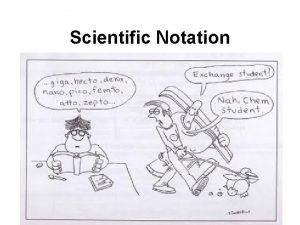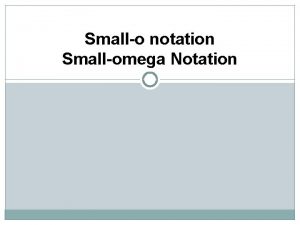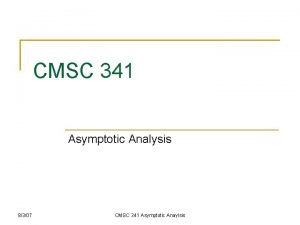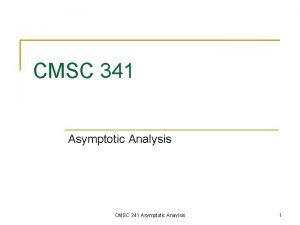Advanced algorithms asymptotic notation graphs and their representation
































- Slides: 32

Advanced algorithms asymptotic notation, graphs and their representation in computers Jiří Vyskočil, Radek Mařík 2013

Introduction n Subject WWW pages: https: //cw. felk. cvut. cz/doku. php/courses/ae 4 m 33 pal/start n Goals Individual implementation of variants of standard (basic and intermediate) problems from several selected IT domains with rich applicability. Algorithmic aspects and effectiveness of practical solutions is emphasized. The seminars are focused mainly on implementation elaboration and preparation, the lectures provide a necessary theoretical foundation. n Prerequisites The course requires programming skills in at least one of programming languages C/C++/Java. There also homework programming tasks. Understanding to basic data structures such as arrays, lists, and files and their usage for data processing is assumed. Advanced algorithms 2 / 32

Asymptotic notation n Asymptotic upper bound: n Meaning: The value of the function n f is on or below the value of the g (within a constant factor) Definition: Advanced algorithms 3 / 32

Asymptotic notation n Asymptotic lower bound : n Meaning: The value of the function n f is on or above the value of the g (within a constant factor) Definition: Advanced algorithms 4 / 32

Asymptotic notation n Asymptotic tight bound : n Meaning: The value of the function n f is equal to the value of the g (within a constant factor). Definition: Advanced algorithms 5 / 32

Asymptotic notation n n Example: Consider two-dimensional array Mx. N of integers. What is asymptotic growth of searching for the maximum number in this array? upper: n n O((M+N)2) O(max(M, N)2) O(N 2) O(M N) n n n (1) (M N) tight: n Advanced algorithms lower: (M N) 6 / 32

Graphs n A graph is an ordered pair of a set of vertices (nodes) and a set of edges (arcs) e n where V is a set of vertices and E is a set of edges such as: n b c a d Example: V={a, b, c, d, e} ¨ E={{a, b}, {b, e}, {e, c}, {c, d}, {d, a}, {a, c}, {b, d}, {b, c}} ¨ Advanced algorithms 7 / 32

Graphs - orientation n Undirected graph Edge is not ordered pair of vertices ¨ E={{a, b}, {b, e}, {e, c}, {c, d}, {d, a}, {a, c}, {b, d}, {b, c}} ¨ e n Directed graph (digraph) Edge is an ordered pair of vertices E={(b, a), (b, e), (c, d), (a, d), (c, a), (b, d), (b, c)} ¨ e b c a d Advanced algorithms 8 / 32

Graphs – weighted graph n Weighted graph ¨A number (weight) is assigned to each edge ¨ Often, the weight is formalized using a weight function: e 0. 3 2. 0 w({a, b}) = 1. 1 w({a, c})= 7. 2 w({b, e}) = 2. 0 w({b, d})= 10 w({e, c}) = 0. 3 w({b, c})= 0 b Advanced algorithms 10 c 6. 8 1. 1 w({c, d}) = 6. 8 w({d, a}) = -2. 4 0 7. 2 a -2. 4 d 9 / 32

Graphs – node degree n incidence ¨ n If two nodes x, y are linked by edge e, nodes x, y are said to be incident to edge e or, edge e is incident to nodes x, y. Node degree (for undirected graph) ¨ A function that returns a number of edges incident to a given node. e deg(a)=3 deg(b)=4 deg(c)=4 deg(d)=3 deg(e)=2 Advanced algorithms b c a d 10 / 32

Graphs – node degree n Node degree (for directed graphs) ¨ indegree ¨ outdegree e deg+(a)=2 deg+(b)=0 deg+(c)=1 deg+(d)=3 deg+(e)=2 Advanced algorithms deg-(a)=1 deg-(b)=4 deg-(c)=3 deg-(d)=0 deg-(e)=0 b c a d 11 / 32

Graphs – handshaking lemma n Handshaking lemma (for undirected graphs) n Explanation: Each edges is added twice – once for the source node, then once for target node. n The variant for directed graphs Advanced algorithms 12 / 32

Graphs – complete graph n complete graph ¨ Every two nodes are linked by an edge 1 ¨A consequence 6 2 5 3 4 Advanced algorithms 13 / 32

Graphs – path, circuit, cycle n ¨ n A path is a sequence of vertices and 2 6 edges (v 0, e 1, v 1, . . . , et, vt ), where all vertices v 0, . . . , vt differ from each 5 3 other and for every i = 1, 2, . . . , t, ei = {vi-1, vi} E(G). Edges are traversed 4 in forward direction. (1, {1, 6}, 6, {6, 5}, 5, {5, 3}, 3, {3, 4}, 4) circuit ¨ n 1 path A circuit is a closed path, i. e. a sequence (v 0, e 1, v 1, . . . , et, vt = v 0), . 1 6 2 5 3 cycle ¨ A cycle is a closed simple chain. Edges can be traversed in both directions. Advanced algorithms 4 (2, {2, 5}, 5, {5, 3}, 3, {3, 2}, 2) 14 / 32

Graphs – connectivity n connectivity G is connected if for every pair of vertices x and y in G, there is a path from x to y. ¨ Graph Connected graph Advanced algorithms Disconnected graph 15 / 32

Graphs - trees n tree The following definitions of a tree (graph G) are equivalent: ¨ G is a connected graph without cycles. ¨ G is such a graph so that a cycle occurs if an arbitrary new edges is added. ¨ G is such a connected graph so that it becomes disconnected if any edge is removed. ¨ G is a connected graph with |V|-1 edges. ¨ G is a graph in which every two vertices are connected by just one path. Advanced algorithms 16 / 32

Graphs - trees n Undirected trees ¨ n A leaf is a node of degree 1. Directed trees (the orientation might be opposite sometimes!) A leaf is a node with no outgoing edge. ¨ A root is a node with no incoming edge. ¨ Advanced algorithms 17 / 32

Graphs – adjacency matrix n Adjacency matrix ¨ Let G=(V, E) be a graph with n vertices. Let’s label vertices v 1, …, vn (in some order). Adjacency matrix of graph G is a square matrix defined as follows Advanced algorithms 18 / 32

Graphs – adjacency matrix (for directed graph) 1 2 3 4 5 1 0 1 1 0 0 2 0 0 0 3 0 1 0 0 0 4 1 1 1 0 0 5 0 1 1 0 0 v 5 v 2 v 1 Advanced algorithms v 3 v 4 19 / 32

Graphs – Laplacian matrix n Laplacian matrix ¨ Let G=(V, E) be a graph with n vertices Let’s label vertices v 1, …, vn (in an arbitrary order). Laplacian matrix of graph G is a square matrix defined as follows Advanced algorithms 20 / 32

Graphs – Laplacian matrix 1 2 3 4 5 1 3 -1 -1 -1 0 2 -1 4 -1 -1 -1 3 -1 -1 4 -1 -1 -1 3 0 5 0 -1 -1 0 2 v 5 v 2 v 1 Advanced algorithms v 3 v 4 21 / 32

Graphs – distance matrix n Distance matrix ¨ Let G=(V, E) is a graph with n vertices and a weight function w. Let’s label vertices v 1, …, vn (in an arbitrary order). Distance matrix of graph G is a square matrix defined by the formula Advanced algorithms 22 / 32

Graphs – DAG n DAG (Directed Acyclic Graph) ¨ DAG Advanced algorithms is a directed graph without cycles (=acyclic) 23 / 32

Graphs – multigraph n Multigraph (pseudograph) ¨ It is a graph where multiple edges and/or edges incident to a single node are allowed. Advanced algorithms 24 / 32

Graphs – incidence matrix n Incidence matrix ¨ Let G=(V, E) be a graph where |V|=n and |E|=m. Let’s label vertices v 1, …, vn (in some arbitrary order) and edges e 1, …, em (in some arbitrary order). Incidence matrix of graph G is a matrix of type defined by the formula In other words, every edge has -1 at the source vertex and +1 at the target vertex. There is +1 at both vertices for undirected graphs. Advanced algorithms 25 / 32

Graphs – incidence matrix 1 2 3 4 5 6 7 8 1 0 0 1 -1 0 0 -1 0 2 0 0 0 1 1 1 0 1 3 1 1 0 0 0 -1 1 0 4 0 -1 -1 0 0 -1 5 -1 0 0 0 e 5 v 2 v 5 e 6 e 7 e 4 Advanced algorithms v 1 e 1 v 3 e 8 e 3 e 2 v 4 26 / 32

Graphs – adjacency list n adjacency list (list of neighbours) In an adjacency list representation, we keep, for each vertex in the graph, a list of all other vertices which it has an edge to (that vertex's "adjacency list"). ¨ For instance, the adjacency list of graph G could be an array P of pointers of size n, where P[i] points to a linked list of all node indices to which node vi is linked by an edge (similarly defined for the case of directed graph). ¨ v 5 v 1 2 3 4 v 2 5 3 1 4 v 3 4 2 1 5 v 4 3 1 2 v 5 2 3 A hash list or a hash table (instead of a linked list) can improve access times to vertices. Advanced algorithms v 2 v 1 v 3 v 4 27 / 32

Adjacency Matrix Storage Comparison of graph representations Laplacian Matrix 2 |V| ∈ O(|V| ) Add vertex 2 O(|V| ) Add edge Adjacency List O(|V|+|E|) |V| |E| ∈ O(|V| |E|) O(|V| |E|) O(1) Remove vertex 2 Incidence Matrix O(|V| ) O(|E|) O(|V| |E|) Remove edge O(1) O(|V| |E|) Query: are vertices u, v adjacent? O(1) deg(v) ∈ O(|V|) O(|E|) deg(v) ∈ O(|V|) |E| ∈ O(|E|) Query: get node degree of vertex v (=deg(v)) Remarks Advanced algorithms |V| ∈ O(|V|) O(1) Slow to add or remove vertices, because matrix must be resized/copied When removing edges or vertices, need to find all vertices or edges Slow to add or remove vertices and edges, because matrix must be resized/copied 28 / 32

Graphs - DFS n DFS - Depth First Search procedure dfs(start_vertex : Vertex) var to_visit : Stack = empty; visited : Vertices = empty; { to_visit. push(start_vertex); while (size(to_visit) != 0) { v = to_visit. pop(); if v not in visited then { visited. add(v); for all x in neighbors of v { to_visit. push(x); } } Advanced algorithms 29 / 32

Graphs - BFS n BFS - Breadth First Search procedure bfs(start_vertex : Vertex) var to_visit : Queue = empty; visited : Vertices = empty; { to_visit. push(start_vertex); while (size(to_visit) != 0) { v = to_visit. pop(); if v not in visited then { visited. add(v); for all x in neighbors of v { to_visit. push(x); } } Advanced algorithms 30 / 32

Graphs – priority queue n priority queue ¨ Is a queue with operation insert to the queue with a priority. ¨ In case the priority is the lowest, the queue behaves as push into a normal queue. ¨ In case the priority is the highest, the queue behaves as push into a stack. ¨ Both DFS and BFS might be realized using a priority queue with an appropriate value of priority during inserting of elements. Advanced algorithms 31 / 32

References n Matoušek, J. ; Nešetřil, J. Kapitoly z diskrétní matematiky. Karolinum. Praha 2002. ISBN 978 -80 -246 -1411 -3. n Cormen, Thomas H. ; Leiserson, Charles E. ; Rivest, Ronald L. ; Stein, Clifford (2001). Introduction to Algorithms (2 nd ed. ). MIT Press and Mc. Graw-Hill. ISBN 0 -262 -53196 -8. Advanced algorithms 32 / 32
 Keadaan dari kompleksitas waktu
Keadaan dari kompleksitas waktu Asymptotic notation exercises
Asymptotic notation exercises Asymptotically tight bound
Asymptotically tight bound Indegree and outdegree of graph
Indegree and outdegree of graph Small omega notation
Small omega notation Interpolation search formula
Interpolation search formula Software implementation of state graph
Software implementation of state graph Graphs that enlighten and graphs that deceive
Graphs that enlighten and graphs that deceive Inductive representation learning on large graphs
Inductive representation learning on large graphs Comparing distance/time graphs to speed/time graphs
Comparing distance/time graphs to speed/time graphs Degree and leading coefficient
Degree and leading coefficient Apa itu asimtotik
Apa itu asimtotik Information theory asymptotic equipartition principle aep
Information theory asymptotic equipartition principle aep Asymptotic complexity analysis
Asymptotic complexity analysis Big o notation rules
Big o notation rules Asymptotic running time
Asymptotic running time Asymptotic analysis
Asymptotic analysis Compare asymptotic growth rate
Compare asymptotic growth rate Lower bounds for sorting
Lower bounds for sorting Asymptotic freedom
Asymptotic freedom Growth of functions
Growth of functions Engineering notation is in steps of what
Engineering notation is in steps of what Polish notation
Polish notation What is reverse polish notation
What is reverse polish notation Horizontal asymptote rules
Horizontal asymptote rules Quadratic functions and their graphs
Quadratic functions and their graphs Vertical answer
Vertical answer Quadratic graphs and their properties
Quadratic graphs and their properties Expander graphs and their applications
Expander graphs and their applications Chapter 1 functions and their graphs
Chapter 1 functions and their graphs 3-1 inequalities and their graphs
3-1 inequalities and their graphs Sketch the graph of the following rational function
Sketch the graph of the following rational function Common functions and their graphs
Common functions and their graphs


